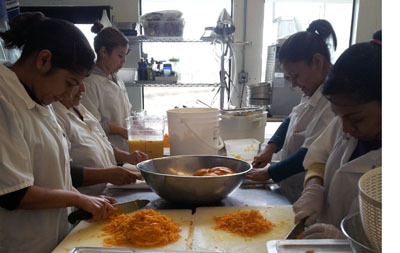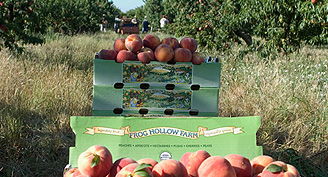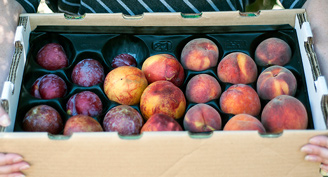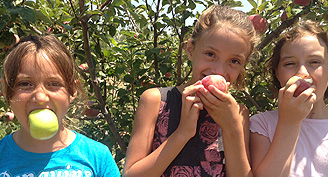 Right now, in our walk-in refer at the farm; there are 10, 20 gallon containers on carts filled with steaming Meyer lemon rind and 5 gallon buckets filled with their juice. After they’ve cooled (tomorrow) these empty halves will be removed of their white pith and sliced in to roughly 1 inch strips about a quarter inch wide. I say “roughly” and “about” because they will be hand cut with a 10 inch utility knife by our kitchen crew. As adept they are at cutting lemon rind, and they’ve been doing it a long time now, not every piece will be totally uniform. And that’s fine. If we get started early enough we may be able to actually making the marmalade tomorrow otherwise, it will have to wait until the following day.
Marmalade making is a long process. The rind of citrus is bitter and that peel needs to be cooked first before you can cook the marmalade. I have made marmalade by very thinly slicing the peel on a deli slicer but, very few of us have access to that kind of equipment. (I admit using the slicer scares me; especially for length of time one would need to use it to make the amount of marmalade we make.) Mandolins are fine and so are box graters if you don’t mind the occasional loss of skin; from your hand that is. You are always left with a ¾ inch thick piece that you wisely chose not to try to pass over the mandolin blade that needs to be cut by hand anyway. You just can’t cut it thin enough with a knife by hand; too thick and the peel won’t soften enough and you’ll have tough and bitter chunks of peel. It is also difficult to separate out and remove the seeds from the slices, and Meyer Lemons are usually very seedy. When I worked at Oliveto I would make marmalade by boiling the whole fruit in water (a method I learned from Jane Grigson’s Fruit Book) and then leaving it in the walk- in overnight to cool. The next day we would cut the soft fruit, discard most of the liquid (keeping some as it has not only flavor but pectin from the peel), and cook the rind and all its pith with sugar. We made a wonderful grapefruit rhubarb marmalade using this method but I always mourned the loss of the fresh juice which I think adds brightness to the flavor.
I have tried many different methods and I always end up making marmalade the way we do now; juicing the fruit, boiling the peel until soft, cutting it into strips and cooking the juice, peel and sugar together. At the time, I was experimenting with some low-methoxyl pectin (pectin requiring less sugar to activate) in jelly; I decided to try it with the Meyer Lemon marmalade. Meyer Lemons have a bright and flowery fragrant flavor and I felt that the length of cooking time it was taking to get a good set was cooking out the unique flavor of the lemons. I liked it. We took off more white pith so the marmalade had small, pieces of zest suspended in a perfectly set jelly. I scooped off some of the pith because while that is where the pectin lies, at times the pith will toughen when it cooks and stay white and not translucent as it should be. I was very happy with this marmalade but my one concern was that over time, it darkened, which isn’t in itself a problem, but it took on an astringent flavor I don’t care for that I have tasted in other marmalades.
I had wanted to change the recipe and CCOF was the catalyst for that change. Up until now, non-organic pectin could be used in a product labeled “organic” but last year they changed that rule. I am happy to tell you that we are now capturing the natural pectin from the pith that we previously discarded in liquid form and we’re adding it back into the marmalade. The jelly set is a little softer, but I think that’s fine. It’s a little sweeter than it was before but I think the extra sugar will help it age a little better. The fruit to sugar ratio is still about 4:3 depending on the sweetness of the fruit, which is still much less sugar than most marmalades. We’re also using this method in the navel orange marmalade, even though it never had pectin as an ingredient. We’re not coking it as long, giving it a brighter flavor and color as well. I am very happy with both the marmalades and I hope that you will be too.
Other news on the marmalade front: we’ll soon be producing a blood orange strawberry marmalade. Having had a wind fall of delicious, sweet strawberries late last summer from Dirty Girl Farms and a crop shortage of our cherries, we were not able to make as much strawberry cherry conserve as we would have liked. The color of the marmalade is a deep reddish burgundy and it has what I think is a perfect balance of blood orange and strawberry. It will be in limited supply we probably won’t be able to make it after May so get it while it lasts!
Right now, in our walk-in refer at the farm; there are 10, 20 gallon containers on carts filled with steaming Meyer lemon rind and 5 gallon buckets filled with their juice. After they’ve cooled (tomorrow) these empty halves will be removed of their white pith and sliced in to roughly 1 inch strips about a quarter inch wide. I say “roughly” and “about” because they will be hand cut with a 10 inch utility knife by our kitchen crew. As adept they are at cutting lemon rind, and they’ve been doing it a long time now, not every piece will be totally uniform. And that’s fine. If we get started early enough we may be able to actually making the marmalade tomorrow otherwise, it will have to wait until the following day.
Marmalade making is a long process. The rind of citrus is bitter and that peel needs to be cooked first before you can cook the marmalade. I have made marmalade by very thinly slicing the peel on a deli slicer but, very few of us have access to that kind of equipment. (I admit using the slicer scares me; especially for length of time one would need to use it to make the amount of marmalade we make.) Mandolins are fine and so are box graters if you don’t mind the occasional loss of skin; from your hand that is. You are always left with a ¾ inch thick piece that you wisely chose not to try to pass over the mandolin blade that needs to be cut by hand anyway. You just can’t cut it thin enough with a knife by hand; too thick and the peel won’t soften enough and you’ll have tough and bitter chunks of peel. It is also difficult to separate out and remove the seeds from the slices, and Meyer Lemons are usually very seedy. When I worked at Oliveto I would make marmalade by boiling the whole fruit in water (a method I learned from Jane Grigson’s Fruit Book) and then leaving it in the walk- in overnight to cool. The next day we would cut the soft fruit, discard most of the liquid (keeping some as it has not only flavor but pectin from the peel), and cook the rind and all its pith with sugar. We made a wonderful grapefruit rhubarb marmalade using this method but I always mourned the loss of the fresh juice which I think adds brightness to the flavor.
I have tried many different methods and I always end up making marmalade the way we do now; juicing the fruit, boiling the peel until soft, cutting it into strips and cooking the juice, peel and sugar together. At the time, I was experimenting with some low-methoxyl pectin (pectin requiring less sugar to activate) in jelly; I decided to try it with the Meyer Lemon marmalade. Meyer Lemons have a bright and flowery fragrant flavor and I felt that the length of cooking time it was taking to get a good set was cooking out the unique flavor of the lemons. I liked it. We took off more white pith so the marmalade had small, pieces of zest suspended in a perfectly set jelly. I scooped off some of the pith because while that is where the pectin lies, at times the pith will toughen when it cooks and stay white and not translucent as it should be. I was very happy with this marmalade but my one concern was that over time, it darkened, which isn’t in itself a problem, but it took on an astringent flavor I don’t care for that I have tasted in other marmalades.
I had wanted to change the recipe and CCOF was the catalyst for that change. Up until now, non-organic pectin could be used in a product labeled “organic” but last year they changed that rule. I am happy to tell you that we are now capturing the natural pectin from the pith that we previously discarded in liquid form and we’re adding it back into the marmalade. The jelly set is a little softer, but I think that’s fine. It’s a little sweeter than it was before but I think the extra sugar will help it age a little better. The fruit to sugar ratio is still about 4:3 depending on the sweetness of the fruit, which is still much less sugar than most marmalades. We’re also using this method in the navel orange marmalade, even though it never had pectin as an ingredient. We’re not coking it as long, giving it a brighter flavor and color as well. I am very happy with both the marmalades and I hope that you will be too.
Other news on the marmalade front: we’ll soon be producing a blood orange strawberry marmalade. Having had a wind fall of delicious, sweet strawberries late last summer from Dirty Girl Farms and a crop shortage of our cherries, we were not able to make as much strawberry cherry conserve as we would have liked. The color of the marmalade is a deep reddish burgundy and it has what I think is a perfect balance of blood orange and strawberry. It will be in limited supply we probably won’t be able to make it after May so get it while it lasts!
 Right now, in our walk-in refer at the farm; there are 10, 20 gallon containers on carts filled with steaming Meyer lemon rind and 5 gallon buckets filled with their juice. After they’ve cooled (tomorrow) these empty halves will be removed of their white pith and sliced in to roughly 1 inch strips about a quarter inch wide. I say “roughly” and “about” because they will be hand cut with a 10 inch utility knife by our kitchen crew. As adept they are at cutting lemon rind, and they’ve been doing it a long time now, not every piece will be totally uniform. And that’s fine. If we get started early enough we may be able to actually making the marmalade tomorrow otherwise, it will have to wait until the following day.
Marmalade making is a long process. The rind of citrus is bitter and that peel needs to be cooked first before you can cook the marmalade. I have made marmalade by very thinly slicing the peel on a deli slicer but, very few of us have access to that kind of equipment. (I admit using the slicer scares me; especially for length of time one would need to use it to make the amount of marmalade we make.) Mandolins are fine and so are box graters if you don’t mind the occasional loss of skin; from your hand that is. You are always left with a ¾ inch thick piece that you wisely chose not to try to pass over the mandolin blade that needs to be cut by hand anyway. You just can’t cut it thin enough with a knife by hand; too thick and the peel won’t soften enough and you’ll have tough and bitter chunks of peel. It is also difficult to separate out and remove the seeds from the slices, and Meyer Lemons are usually very seedy. When I worked at Oliveto I would make marmalade by boiling the whole fruit in water (a method I learned from Jane Grigson’s Fruit Book) and then leaving it in the walk- in overnight to cool. The next day we would cut the soft fruit, discard most of the liquid (keeping some as it has not only flavor but pectin from the peel), and cook the rind and all its pith with sugar. We made a wonderful grapefruit rhubarb marmalade using this method but I always mourned the loss of the fresh juice which I think adds brightness to the flavor.
I have tried many different methods and I always end up making marmalade the way we do now; juicing the fruit, boiling the peel until soft, cutting it into strips and cooking the juice, peel and sugar together. At the time, I was experimenting with some low-methoxyl pectin (pectin requiring less sugar to activate) in jelly; I decided to try it with the Meyer Lemon marmalade. Meyer Lemons have a bright and flowery fragrant flavor and I felt that the length of cooking time it was taking to get a good set was cooking out the unique flavor of the lemons. I liked it. We took off more white pith so the marmalade had small, pieces of zest suspended in a perfectly set jelly. I scooped off some of the pith because while that is where the pectin lies, at times the pith will toughen when it cooks and stay white and not translucent as it should be. I was very happy with this marmalade but my one concern was that over time, it darkened, which isn’t in itself a problem, but it took on an astringent flavor I don’t care for that I have tasted in other marmalades.
I had wanted to change the recipe and CCOF was the catalyst for that change. Up until now, non-organic pectin could be used in a product labeled “organic” but last year they changed that rule. I am happy to tell you that we are now capturing the natural pectin from the pith that we previously discarded in liquid form and we’re adding it back into the marmalade. The jelly set is a little softer, but I think that’s fine. It’s a little sweeter than it was before but I think the extra sugar will help it age a little better. The fruit to sugar ratio is still about 4:3 depending on the sweetness of the fruit, which is still much less sugar than most marmalades. We’re also using this method in the navel orange marmalade, even though it never had pectin as an ingredient. We’re not coking it as long, giving it a brighter flavor and color as well. I am very happy with both the marmalades and I hope that you will be too.
Other news on the marmalade front: we’ll soon be producing a blood orange strawberry marmalade. Having had a wind fall of delicious, sweet strawberries late last summer from Dirty Girl Farms and a crop shortage of our cherries, we were not able to make as much strawberry cherry conserve as we would have liked. The color of the marmalade is a deep reddish burgundy and it has what I think is a perfect balance of blood orange and strawberry. It will be in limited supply we probably won’t be able to make it after May so get it while it lasts!
Right now, in our walk-in refer at the farm; there are 10, 20 gallon containers on carts filled with steaming Meyer lemon rind and 5 gallon buckets filled with their juice. After they’ve cooled (tomorrow) these empty halves will be removed of their white pith and sliced in to roughly 1 inch strips about a quarter inch wide. I say “roughly” and “about” because they will be hand cut with a 10 inch utility knife by our kitchen crew. As adept they are at cutting lemon rind, and they’ve been doing it a long time now, not every piece will be totally uniform. And that’s fine. If we get started early enough we may be able to actually making the marmalade tomorrow otherwise, it will have to wait until the following day.
Marmalade making is a long process. The rind of citrus is bitter and that peel needs to be cooked first before you can cook the marmalade. I have made marmalade by very thinly slicing the peel on a deli slicer but, very few of us have access to that kind of equipment. (I admit using the slicer scares me; especially for length of time one would need to use it to make the amount of marmalade we make.) Mandolins are fine and so are box graters if you don’t mind the occasional loss of skin; from your hand that is. You are always left with a ¾ inch thick piece that you wisely chose not to try to pass over the mandolin blade that needs to be cut by hand anyway. You just can’t cut it thin enough with a knife by hand; too thick and the peel won’t soften enough and you’ll have tough and bitter chunks of peel. It is also difficult to separate out and remove the seeds from the slices, and Meyer Lemons are usually very seedy. When I worked at Oliveto I would make marmalade by boiling the whole fruit in water (a method I learned from Jane Grigson’s Fruit Book) and then leaving it in the walk- in overnight to cool. The next day we would cut the soft fruit, discard most of the liquid (keeping some as it has not only flavor but pectin from the peel), and cook the rind and all its pith with sugar. We made a wonderful grapefruit rhubarb marmalade using this method but I always mourned the loss of the fresh juice which I think adds brightness to the flavor.
I have tried many different methods and I always end up making marmalade the way we do now; juicing the fruit, boiling the peel until soft, cutting it into strips and cooking the juice, peel and sugar together. At the time, I was experimenting with some low-methoxyl pectin (pectin requiring less sugar to activate) in jelly; I decided to try it with the Meyer Lemon marmalade. Meyer Lemons have a bright and flowery fragrant flavor and I felt that the length of cooking time it was taking to get a good set was cooking out the unique flavor of the lemons. I liked it. We took off more white pith so the marmalade had small, pieces of zest suspended in a perfectly set jelly. I scooped off some of the pith because while that is where the pectin lies, at times the pith will toughen when it cooks and stay white and not translucent as it should be. I was very happy with this marmalade but my one concern was that over time, it darkened, which isn’t in itself a problem, but it took on an astringent flavor I don’t care for that I have tasted in other marmalades.
I had wanted to change the recipe and CCOF was the catalyst for that change. Up until now, non-organic pectin could be used in a product labeled “organic” but last year they changed that rule. I am happy to tell you that we are now capturing the natural pectin from the pith that we previously discarded in liquid form and we’re adding it back into the marmalade. The jelly set is a little softer, but I think that’s fine. It’s a little sweeter than it was before but I think the extra sugar will help it age a little better. The fruit to sugar ratio is still about 4:3 depending on the sweetness of the fruit, which is still much less sugar than most marmalades. We’re also using this method in the navel orange marmalade, even though it never had pectin as an ingredient. We’re not coking it as long, giving it a brighter flavor and color as well. I am very happy with both the marmalades and I hope that you will be too.
Other news on the marmalade front: we’ll soon be producing a blood orange strawberry marmalade. Having had a wind fall of delicious, sweet strawberries late last summer from Dirty Girl Farms and a crop shortage of our cherries, we were not able to make as much strawberry cherry conserve as we would have liked. The color of the marmalade is a deep reddish burgundy and it has what I think is a perfect balance of blood orange and strawberry. It will be in limited supply we probably won’t be able to make it after May so get it while it lasts!






